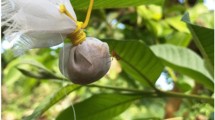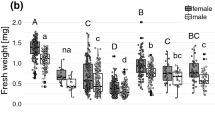Abstract
Our objective was to determine the timing of the highest parasitic activity by released Diachasmimorpha longicaudata (Ashmead) (Hymenoptera: Braconidae) in areas with fruits of sour orange and hog plums infested by Anastrepha ludens (Loew) and Anastrepha obliqua (McQuart) (Diptera: Tephritidae), under shaded and sunny conditions. Percent parasitism along fruit sampling period was related to host availability, which was influenced by the fruit size rather than environmental conditions. The highest parasitism in sour orange was obtained just the first day after release, but in hog plums this was observed during the first 3 days without significant differences between them. The levels of fruit infestation and parasitism were higher in shaded trees in sour orange as in hog plums. The high availability of larvae and the small size of hog plums were decisive for obtaining high levels of parasitism and keeping parasitoids near the release points. By contrast, the size and thick rind of sour orange provided to the larvae a physical refuge that was associated with lower parasitism, causing that parasitoids spread out in search of hosts more accessible. In sour orange, parasitism was exclusively by D. longicaudata, while in hog plums, we additionally found the coexistence of four native parasitoid species. This information suggests that in sour orange, the sampling should be performed 1 day after release, while in hog plums, the samplings can be extended to within the first 3 days. Such sampling can serve to better estimate the effect of D. longicaudata releases against Anastrepha pest populations in different fruit types.





Similar content being viewed by others
References
Aluja M, Guillén J, de la Rosa G, Cabrera M, Celedonio H, Liedo P, Hendrichs J (1987) Natural host plant survey of the economically important fruit flies (Diptera: Tephritidae) of Chiapas, México. Fla Entomol 70:329–338
Bompard A, Amat I, Fauvergue X, Spatao T (2013) Host-parasitoid dynamics and the success of biological control when parasitoids are prone to allee effects. PLoS One 8(10):e76768. https://doi.org/10.1371/journal.Pone.0076768
Camargos MG, Alvarenga CD, Giustolin TA, Paranhos BAJ, do Carmo Oliveira C, Mendes Rabelo M (2016) Dispersal capacity of fruit fly parasitoid Diachasmimorpha longicaudata (Hymenoptera: Braconidae) in irrigated coffee plantations. Sci Agric 73:227–233
Cancino J, Montoya P (2008) Advances and perspectives in the mass rearing of fruit fly parasitoids in Mexico. In: Sugayama RL, Zucchi RA, Ovruski SM, Sivisnki J (eds) Fruit flies of economic importance: from basic to applied knowledge, proceedings of the 7th international symposium on fruit flies of economic importance, Salvador, Bahia, Brazil. Press Color, Bahia, Brazil
Cancino J, Ruiz L, López P, Moreno FM (2010) Cría masiva de parasitoides. In: Montoya P, Toledo J, Hernández E (eds) Moscas de la fruta: Fundamentos y procedimientos para su manejo. SyG Editores, Mexico
Cancino J, López-Arriaga F (2015) Effect of hypoxia and its repercussions in packing pupae of the parasitoid Diachasmimorpha longicaudata (Hymenoptera: Braconidae) for shipment. Biocontrol Sci Tech 26:665–667
Cancino J, López-Arriaga F, Montoya P (2016) Packaging conditions for the field release of the fruit fly parasitoid Diachasmimorpha longicaudata (Hymenoptera: Braconidae). Aust Entomol 56:261–267. https://doi.org/10.1111/aen12229
Celedonio-Hurtado H, Aluja M, Liedo P (1995) Adult population fluctuations of Anastrepha species (Diptera: Tephritidae) in tropical orchards habitats of Chiapas, Mexico. Environ Entomol 24:861–869
Cruz-López L, Malo E, Toledo J, Virgen A, del Mazo A, Rojas JC (2006) A new potential attractant for Anastrepha obliqua from Spondias mombin fruits. J Chem Ecol 32:351–365
Eitam A, Sivinski J, Holler T, Aluja M (2009) Biogeography of braconid parasitoids of the Caribbean fruit fly (Diptera: Tephritidae) in Florida. Ann Entomol Soc Am 97:928–939
García FRM, Ricalde MP (2013) Augmentative biological control using parasitoids for fruit fly management in Brazil. Insects 4:55–70
Grasman J, van Herwaarden O, Hemerik L, van Lenteren J (2001) A two-component of host-parasitoid interactions: determination of the size of inundative releases of parasitoids in biological pest control. Math Biosci 169:207–216
Greathead DJ, Waage JK (1983) Opportunities for Biological Control of Agricultural Pests in Developing Countries. World Bank Technical Paper No. 11
Harbi A, Pedro L. de, Beitia F, Chermiti B, Ferrara FA, Tormos J, Sabater-Muñoz B (2016) Parasitism activity of Diachasmimorpha longicaudata (Ashmead) (Hymenoptera: Braconidae) and Aganaspis daci (Weld) (Hymenoptera: Figitidae) against Ceratitis capitata (Wiedemann) (Diptera: Tephritidae) under Mediterranean climatic conditions. In: Sabater-Muñoz B, Vera T, Pereira R, Orankanok W (eds) Proceedings of the 9th Interational Symposium of Fruit Flies of Economic Importance. CABI, Bangkok, Thailand
Hawkins BA, Thomas MB, Hochberg ME (1993) Refuge theory and biological control. Science 262:1429–1432
Hernández-Ortíz V (1992) El género Anastrepha Schiner en México (Diptera: Tephritidae): taxonomía, distribución y sus plantas huéspedes. Sociedad Mexicana de Entomología, Xalapa Veracruz
Jesus-Barros CR, Adaime R, Oliviera MN, Silva WR, Costa-Neto SV, Souza-Filho MF (2012) Anastrepha (Diptera: Tephritidae) species, their host and parasitoids (Hymenoptera: Braconidae) in five municipalities of the State of Amapá, Brazil. Fla Entomol 95:694–705
JMP® (n.d.) version 7.0.1, SAS Institute Inc., Cary, NC, 1989–2007
Kottek M, Grieser J, Beck C, Rudolf B, Rubel F (2006) Meteor Z 15:259–263. World Map of the Köppen-Geiger climate classification updated. https://doi.org/10.1127/0941-2948/2006/0130
Leyva JL, Browning HW, Gilstrap FE (1991) Effect of host fruit species, size, and color on parasitization of Anastrepha ludens (Diptera: Tephritidae) by Diachasmimorpha longicaudata (Hymenoptera: Braconidae). Environ Entomol 20:1469–1474
López M, Aluja M, Sivinski J (1999) Hymenopterous larval-pupal and pupal parasitoids of Anastrepha flies (Diptera: Tephritidae) in Mexico. Biol Control 15:119–129
Messing RH, Klungness LM, Purcell MF (1994) Short-range dispersal of mass-reared Diachasmimorpha longicaudata and D. tryoni (Hymenoptera: Braconidae), parasitoids of tephritid fruit flies. J Econ Entomol 87:975–985
Montoya P, Liedo P, Benrey B, Cancino J, Barrera JF, Sivinski J, Aluja M (2000) Biological control of Anastrepha spp. (Diptera: Tephritidae) in mango orchards through augmentative releases of Diachasmimorpha longicaudata (Ashmead) (Hymenoptera: Braconidae). Biol Control 18:216–224
Montoya P, Cancino J, Zenil M, Santiago G, Gutiérrez JM (2007) The augmentative biological control component in the Mexican National Campaign against Anastrepha spp. fruit flies. In: Vreysen MJB, Robinson AS, Hendrichs J (eds) Area-wide control of insect pests. Springer, The Netherlands
Montoya P, Cancino J, Pérez-Lachaud G, Liedo P (2011) Host size, superparasitism and sex ratio in mass reared Diachasmimorpha longicaudata, a fruit fly parasitoid. BioControl 56:11–17
Montoya P, Cancino J, Ruiz L (2012) Packing of fruit fly parasitoids for augmentative releases. Insects 3:889–899
Montoya P, López P, Cruz J, López F, Cadena C, Cancino J, Liedo P (2017) Effect of Diachasmimorpha longicaudata releases on the native parasitoid guild attacking Anastrepha spp. larvae in disturbed zones of Chiapas, Mexico. BioControl 62:581–593
Ovruski SM, Aluja M, Sivinski J, Wharton R (2000) Hymenopteran parasitoids on fruit-infesting Tephritidae (Diptera) in Latin America and the Southern United States: diversity, distribution, taxonomic status and their use in fruit fly biological control. Integr Pest Manag Rev 5:81–107
Ovruski SM, Schliserman P (2012) Biological control of Tephritid fruit flies in Argentina: historical review, current status, and future trends for developing a parasitoid mass-releases program. Insects 3:870–888
Paranhos BAJ, Mendes PCD, Papadopoulos NT, Walder JMM (2007) Dispersion patterns of Diachasmimorpha longicaudata (Hymenoptera: Braconidae) in citrus orchards in Southeast Brazil. Biocontrol Sci Tech 17:375–385
R core Team (2005) R: a language and environment for statistical computing. R Foundation for statistical computing. Vienna, Austria, URL http://www.R-project.org/
Schliserman P, Ovruski SM, De Coll OR, Wharton R (2010) Diversity and abundance of hymenopterous parasitoids associated with Anastrepha fraterculus (Diptera: Tephritidae) in native and exotic host plants in Misiones, Northeastern, Argentina. Fla Entomol 93:175–182
Sime KR, Daane KM, Nedel H, Funk CS, Messing RH, Andrews JW Jr, Johnson MW, Pickett CH (2006) Diachasmimorpha longicaudata and D. kraussii (Hymenoptera: Braconidae), potential parasitoids of the olive fruit fly. Biocontrol Sci Tech 16:169–179
Sivinski JM (1996) The past and potential of biological control of fruit flies. In: McPheron BA, Steck GJ (eds) Fruit fly pest: world assessment of their biology and management. St. Lucie Press, USA
Sivinski J (1991) The influence of host morphology on parasitization rates in the Caribbean fruit fly Anastrepha suspensa. Entomophaga 36:447–454
Sivinski J, Calkins CO, Baranowski R, Harris D, Brambila J, Diaz J, Burns RE, Holler T, Dodson G (1996) Suppression of a Caribbean fruit fly (Anastrepha suspensa (Loew) Diptera: Tephritidae) population through augmented releases of the parasitoid Diachasmimorpha longicaudata (Ashmead) (Hymenoptera: Braconidae). Biol Control 6:177–185
Sivinski J, Aluja M (2012) The roles of parasitoid foraging for hosts, food and mates in the augmentative control of Tephritidae. Insects 3:668–691
Van Driesche RG (1983) Meaning of “percent parasitism” in studies of insect parasitoids. Environ Entomol 12:1611–1622
Van Driesche RG, Bellows TS Jr, Elkinton JS, Gould JR, Ferro DN (1991) The meaning of percentage parasitism revisited: solutions to the problem of accurately estimating total losses from parasitism. Environ Entomol 20:1–7
Wang XG, Johnson MW, Daane KM, Yokoyama VY (2009) Larger olive fruit size reduces the efficiency of Psittalia concolor, as a parasitoid of the olive fruit fly. Biol Control 49:45–51
Wharton RA, Marsh PM (1978) New world Opiinae (Hymenoptera: Braconidae) parasitic on Tephritidae (Diptera). J Wash Acad Sci 68:147–167
Wheler B, Torchiano M (2016) Lmperm: permutation for linear models. R Packaging Version 2.1.0
Wong TTY, Ramadan MM, McInnis DO, Mochizuki N, Nishimoto JA, Herr JC (1991) Augmentative releases of Diachasmimorpha tryoni (Hymenoptera: Braconidae) to suppress a Mediterranean fruit fly (Diptera: Tephritidae) population in Kula, Maui, Hawaii. Biol Control 1:2–7
Wong TTY, Ramadan MM, Herr JC, McInnis DO (1992) Suppression of a Mediterranean fruit fly (Diptera: Tephritidae) population with concurrent parasitoid and sterile fly releases in Kula, Maui, Hawaii. J Econ Entomol 85:1671–1681
Acknowledgments
We thank the technical assistance of the Biological Control laboratory staff of Moscafrut Program. We also thank Javier Valle-Mora (ECOSUR) for the statistical advice. Fredy O. Galvez helped us choose the most representative fruit sampling areas. We appreciate the support by Francisco Ramirez y Ramirez, Director of the National Program of Fruit Flies in México.
Author information
Authors and Affiliations
Corresponding author
Additional information
Edited by Tiago Cardoso da Costa Lima – Embrapa
Rights and permissions
About this article
Cite this article
Cancino, J., Gálvez, C., López, A. et al. Best Timing to Determine Field Parasitism by Released Diachasmimorpha longicaudata (Hymenoptera: Braconidae) Against Anastrepha (Diptera: Tephritidae) Pest Populations. Neotrop Entomol 48, 143–151 (2019). https://doi.org/10.1007/s13744-018-0622-7
Received:
Accepted:
Published:
Issue Date:
DOI: https://doi.org/10.1007/s13744-018-0622-7




